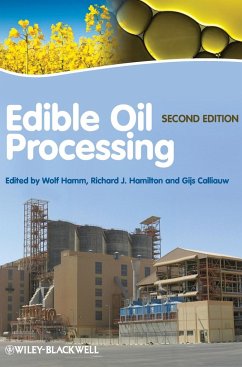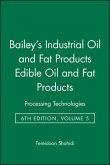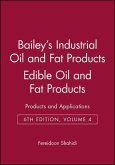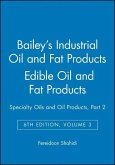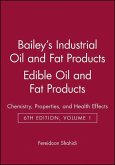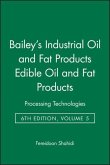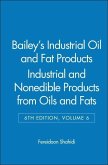Edible Oil Processing, 2nd Edition
Herausgegeben von Hamm, Wolf; Hamilton, Richard J.; Calliauw, Gijs
Edible Oil Processing, 2nd Edition
Herausgegeben von Hamm, Wolf; Hamilton, Richard J.; Calliauw, Gijs
- Gebundenes Buch
- Merkliste
- Auf die Merkliste
- Bewerten Bewerten
- Teilen
- Produkt teilen
- Produkterinnerung
- Produkterinnerung
Oils and fats are almost ubiquitous in food processing, whether naturally occurring in foods or added as ingredients that bring functional benefits. Whilst levels of fat intake must be controlled in order to avoid obesity and other health problems, it remains the fact that fats (along with proteins and carbohydrates) are one of the three macronutrients and therefore an essential part of a healthy diet.
The ability to process oils and fats to make them acceptable as part of our food supplies is a key component in our overall knowledge of them. Without this ability, the food that we consume…mehr
Andere Kunden interessierten sich auch für
![Bailey's Industrial Oil and Fat Products, Edible Oil and Fat Products Bailey's Industrial Oil and Fat Products, Edible Oil and Fat Products]() Bailey's Industrial Oil and Fat Products, Edible Oil and Fat Products522,99 €
Bailey's Industrial Oil and Fat Products, Edible Oil and Fat Products522,99 €![Bailey's Industrial Oil and Fat Products, Edible Oil and Fat Products Bailey's Industrial Oil and Fat Products, Edible Oil and Fat Products]() Bailey's Industrial Oil and Fat Products, Edible Oil and Fat Products497,99 €
Bailey's Industrial Oil and Fat Products, Edible Oil and Fat Products497,99 €![Bailey's Industrial Oil and Fat Products, Edible Oil and Fat Products Bailey's Industrial Oil and Fat Products, Edible Oil and Fat Products]() Bailey's Industrial Oil and Fat Products, Edible Oil and Fat Products497,99 €
Bailey's Industrial Oil and Fat Products, Edible Oil and Fat Products497,99 €![Bailey's Industrial Oil and Fat Products, Edible Oil and Fat Products Bailey's Industrial Oil and Fat Products, Edible Oil and Fat Products]() Bailey's Industrial Oil and Fat Products, Edible Oil and Fat Products510,99 €
Bailey's Industrial Oil and Fat Products, Edible Oil and Fat Products510,99 €![Bailey's Industrial Oil and Fat Products, Set Bailey's Industrial Oil and Fat Products, Set]() Fereidoon Shahidi (Hrsg.)Bailey's Industrial Oil and Fat Products, Set2.608,99 €
Fereidoon Shahidi (Hrsg.)Bailey's Industrial Oil and Fat Products, Set2.608,99 €![Olive Oil Sensory Science Olive Oil Sensory Science]() Olive Oil Sensory Science190,99 €
Olive Oil Sensory Science190,99 €![Bailey's Industrial Oil and Fat Products, Industrial and Nonedible Products from Oils and Fats Bailey's Industrial Oil and Fat Products, Industrial and Nonedible Products from Oils and Fats]() Fereidoon Shahidi (ed.)Bailey's Industrial Oil and Fat Products, Industrial and Nonedible Products from Oils and Fats510,99 €
Fereidoon Shahidi (ed.)Bailey's Industrial Oil and Fat Products, Industrial and Nonedible Products from Oils and Fats510,99 €-
-
-
Oils and fats are almost ubiquitous in food processing, whether naturally occurring in foods or added as ingredients that bring functional benefits. Whilst levels of fat intake must be controlled in order to avoid obesity and other health problems, it remains the fact that fats (along with proteins and carbohydrates) are one of the three macronutrients and therefore an essential part of a healthy diet.
The ability to process oils and fats to make them acceptable as part of our food supplies is a key component in our overall knowledge of them. Without this ability, the food that we consume would be totally different, and much of the flexibility available to us as a result of the application of processing techniques would be lost. Obviously we need to know how to process fatty oils, but we also need to know how best to use them once they have been processed.
This second edition of Edible Oil Processing presents a valuable overview of the technology and applications behind the subject.
It covers the latest technologies which address new environmental and nutritional requirements as well as the current state of world edible oil markets.
This book is intended for food scientists and technologists who use oils and fats in food formulations, as well as chemists and technologists working in edible oils and fats processing.
Hinweis: Dieser Artikel kann nur an eine deutsche Lieferadresse ausgeliefert werden.
The ability to process oils and fats to make them acceptable as part of our food supplies is a key component in our overall knowledge of them. Without this ability, the food that we consume would be totally different, and much of the flexibility available to us as a result of the application of processing techniques would be lost. Obviously we need to know how to process fatty oils, but we also need to know how best to use them once they have been processed.
This second edition of Edible Oil Processing presents a valuable overview of the technology and applications behind the subject.
It covers the latest technologies which address new environmental and nutritional requirements as well as the current state of world edible oil markets.
This book is intended for food scientists and technologists who use oils and fats in food formulations, as well as chemists and technologists working in edible oils and fats processing.
Hinweis: Dieser Artikel kann nur an eine deutsche Lieferadresse ausgeliefert werden.
Produktdetails
- Produktdetails
- Verlag: Wiley & Sons
- Artikelnr. des Verlages: 1A444336840
- 2. Aufl.
- Seitenzahl: 352
- Erscheinungstermin: 5. August 2013
- Englisch
- Abmessung: 250mm x 175mm x 23mm
- Gewicht: 786g
- ISBN-13: 9781444336849
- ISBN-10: 1444336843
- Artikelnr.: 35676996
- Herstellerkennzeichnung
- Libri GmbH
- Europaallee 1
- 36244 Bad Hersfeld
- gpsr@libri.de
- Verlag: Wiley & Sons
- Artikelnr. des Verlages: 1A444336840
- 2. Aufl.
- Seitenzahl: 352
- Erscheinungstermin: 5. August 2013
- Englisch
- Abmessung: 250mm x 175mm x 23mm
- Gewicht: 786g
- ISBN-13: 9781444336849
- ISBN-10: 1444336843
- Artikelnr.: 35676996
- Herstellerkennzeichnung
- Libri GmbH
- Europaallee 1
- 36244 Bad Hersfeld
- gpsr@libri.de
About the editors Wolf Hamm (retired) has been a consultant to the Oils and Fats Industry, and is based in Harpenden, UK. Richard J. Hamilton is Emeritus Professor at Liverpool John Moores University, UK. Gijs Calliauw is Development Manager Modification at Desmet Ballestra, Belgium.
List of Contributors xiii
List of Abbreviations xv
Introduction xvii
1 Composition and Properties of Edible Oils 1
Frank D. Gunstone
1.1 Introduction 1
1.2 Components of natural fats 3
1.2.1 Fatty acids and glycerol esters 4
1.2.2 Phospholipids 7
1.2.3 Sterols 7
1.2.4 Tocols and other phenolic compounds 9
1.2.5 Chlorophyll 12
1.2.6 Hydrocarbons 13
1.2.6.1 Alkanes 13
1.2.6.2 Squalene 13
1.2.6.3 Carotenes 14
1.2.6.4 Polycyclic aromatic hydrocarbons 15
1.2.6.5 Contaminants and specifications 16
1.3 Fatty acid composition 16
1.4 Physical properties 19
1.4.1 Polymorphism, crystal structure and melting point 19
1.4.2 Density 21
1.4.3 Viscosity 22
1.4.4 Refractive index 22
1.4.5 Solubility of gases in oils 22
1.4.6 Other physical properties 24
1.5 Chemical properties 25
1.5.1 Hydrogenation 25
1.5.2 Oxidation 25
1.5.3 Autoxidation 26
1.5.4 Photooxidation 27
1.5.5 Decomposition of hydroperoxides to short-chain compounds 28
1.5.6 Antioxidants 28
1.5.6.1 Primary antioxidants 28
1.5.6.2 Secondary antioxidants 29
1.5.7 Stereomutation 31
1.5.8 Double-bond migration and cyclisation 31
1.5.9 Hydrolysis 31
1.5.10 Ester formation 32
1.5.11 Methanolysis 32
1.5.12 Glycerolysis 32
1.5.13 Interesterification 33
1.6 Effect of processing on food oil components 33
References 34
2 Bulk Movement of Edible Oils 41
Wolf Hamm
2.1 Oil production and exports 41
2.2 Cargo damage 45
2.3 Quality of oils shipped 47
2.3.1 Palm oil 47
2.3.2 Soybean oil and other seed oils 47
2.3.3 Shipment of oils intended for production of FAMEs 48
2.4 Codex Alimentarius 48
2.5 Oil shipments: systems and regulations 49
2.5.1 The parcel tanker 49
2.5.2 Parcel tanker categories: IMO classification 50
2.5.3 Trade regulation: the role of the FOSFA and NIOP 50
2.6 Shore storage 52
2.7 Movement and storage costs 53
2.8 Refinery location 53
Acknowledgement 53
References 54
3 Production of Oils 55
Philippe van Doosselaere
3.1 Introduction 55
3.2 Seed handling and storage 56
3.2.1 Seed arrival 56
3.2.1.1 Seed weighing 56
3.2.1.2 Sampling 57
3.2.2 Seed reception and precleaning 57
3.2.3 Storage 58
3.3 Preparation of oilseeds 60
3.3.1 Reason for and purpose of preparation 60
3.3.2 Milling defect 61
3.4 Preparation of soybean 61
3.4.1 Cleaning and weighing 62
3.4.2 Cracking 64
3.4.3 Cooking-conditioning 65
3.4.4 Flaking 65
3.4.5 Expander 66
3.4.6 Soybean dehulling 68
3.4.6.1 Traditional process 68
3.4.6.2 Hot dehulling process 69
3.5 Preparation and pressing of rapeseed (canola) 69
3.5.1 Preparation 70
3.5.2 Cooking 71
3.5.3 Mechanical pressing 71
3.5.4 Press oil clarification 75
3.5.5 Press cake treatment 76
3.6 Preparation and pressing of sunflower seed 77
3.7 Full pressing 78
3.7.1 Cold pressing 79
3.7.2 Double pressing 80
3.7.3 Cake treatment 80
3.8 Oil from other seeds 81
3.8.1 Cottonseed 81
3.8.2 Corn germ 82
3.8.3 Coconut or copra oil 83
3.8.4 Linseed (flaxseed) 83
3.8.5 Safflower 84
3.8.6 Peanut (groundnut) 85
3.8.7 Rice bran 86
3.8.8 Sesame seed 87
3.9 Olive oil production 87
3.9.1 Pressing 89
3.9.2 Centrifugation 90
3.9.3 Olive pomace extraction 90
3.10 Palm oil production 91
3.10.1 Before reaching the mill 92
3.10.2 Sterilisation 93
3.10.3 Threshing 93
3.10.4 Pressing 94
3.10.5 Crude oil clarification 94
3.10.6 Oil drying 94
3.10.7 Fibre-fruit separation 95
3.10.8 Nut conditioning 95
3.10.9 Nut cracking installation 95
3.10.10 Kernel separation 95
3.10.11 Uses of secondary palm fruit products 95
3.10.11.1 Palm kernel meal 95
3.10.11.2 Fibres and shell 96
4 Solvent Extraction 97
Timothy G. Kemper
4.1 Introduction 97
4.2 Solvent extractor 99
4.2.1 Contact time 100
4.2.2 Particle thickness 101
4.2.3 Extractor temperature 102
4.2.4 Miscella flux rate 103
4.2.5 Number of miscella stages 105
4.2.6 Solvent retention 107
4.3 Meal desolventiser toaster 107
4.3.1 Predesolventising trays 108
4.3.2 Countercurrent trays 111
4.3.3 Sparge tray 111
4.4 Meal dryer cooler 114
4.4.1 Steam-drying trays 114
4.4.2 Air-drying trays 114
4.4.3 Air-cooling trays 116
4.5 Miscella distillation system 117
4.6 Solvent recovery system 119
4.7 Heat recovery 123
References 125
5 Edible Oil Refining: Current and Future Technologies 127
Wim De Greyt
5.1 Introduction 127
5.2 Next-generation chemical refining with nanoneutralisation 128
5.3 Enzymatic degumming: a missing link in the physical refining of soft
oils? 131
5.4 Bleaching: from single-stage colour removal to multistage adsorptive
purification 136
5.5 Deodorisation: much more than just a process for the removal of
off-flavours 141
5.6 Short-path distillation and supercritical processing: refining
technologies for the future? 148
References 150
6 Oil Modification Processes 153
Marc Kellens and Gijs Calliauw
6.1 Introduction 153
6.2 Hydrogenation 154
6.2.1 Historical perspective 154
6.2.2 Principle 155
6.2.3 Process parameters 157
6.2.3.1 Hydrogen pressure 157
6.2.3.2 Temperature 157
6.2.3.3 Catalyst 157
6.2.4 Process design 159
6.2.5 Future for hydrogenation technology 163
6.2.5.1 Smarter combinations of the conventional technology 163
6.2.5.2 Alternative catalysts 163
6.2.5.3 Advanced process technology 164
6.2.5.4 Summary 166
6.3 Interesterification 166
6.3.1 Historical perspective 166
6.3.2 Principle 167
6.3.3 Process parameters 169
6.3.3.1 Oil quality 169
6.3.3.2 Catalyst 169
6.3.3.3 Oil losses 170
6.3.4 Process design 171
6.3.4.1 Processed product quality 173
6.3.5 Future for interesterification technology 174
6.4 Dry fractionation 175
6.4.1 Historical perspective 176
6.4.2 Principle 177
6.4.3 Process parameters 180
6.4.3.1 Cooling speed 180
6.4.3.2 Agitation 183
6.4.4 Process design 183
6.4.4.1 Crystalliser design 183
6.4.4.2 Filter design 184
6.4.4.3 Plant design 185
6.4.5 Future for fractionation technology 188
6.4.5.1 Optimised crystalliser designs 188
6.4.5.2 High-pressure filtrations 189
6.4.5.3 Continuous fractional crystallisation 190
6.4.5.4 Alternative multistage processes for specialty fats production 191
6.4.6 Summary 195
References 195
7 Enzyme Processing 197
David Cowan
7.1 Introduction 197
7.1.1 Objectives of enzyme processing 198
7.2 Enzyme applications before oil refining 199
7.2.1 Enzyme-assisted pressing 199
7.2.2 Enzymatic degumming 200
7.2.3 Enzymatic degumming process (phospholipase A1) 202
7.2.4 Other phospholipases 205
7.2.5 Oil recovery from gums 205
7.2.6 Oil remediation 206
7.3 Applications within edible oil modification 208
7.3.1 Industrial-scale enzymatic interesterification 209
7.3.2 Factors influencing enzyme working life 211
7.3.3 Formulating with interesterified oils and fats 215
7.3.4 Enzyme reactions for speciality fats 216
7.3.5 Production of fats high in omega-3 fatty acids 217
7.4 Improving processing sustainability through enzyme usage 219
References 221
8 Application of Edible Oils 223
Arjen Bot and Eckhard Fl¿oter
8.1 Introduction 223
8.2 Physical chemistry of triacylglycerides 225
8.3 Fat crystal networks 228
8.4 Design of functional TAG compositions 229
8.5 Application in fat-continuous emulsions (spreads) 234
8.6 Application in water-continuous emulsions 237
8.6.1 Mayonnaise and dressings 237
8.6.2 Nondairy (fat) creams and spreads 238
8.6.3 Ice cream 239
8.7 Application in other fat-continuous products 241
8.7.1 Baking fats 241
8.7.2 Chocolate 242
8.8 Conclusion 245
References 246
9 Quality and Food Safety Assurance and Control 251
Mar Verhoeff and Gerrit van Duijn
9.1 Introduction 251
9.2 Analytical methods for measuring oil and fat composition 252
9.3 Quality analyses 252
9.3.1 Free fatty acids 252
9.3.2 Peroxides 254
9.3.3 Phosphorus 254
9.3.4 Moisture and dirt 255
9.3.5 Colour 256
9.3.6 Metals 256
9.3.7 Deterioration of Bleachability Index 256
9.3.8 Tocopherols 257
9.4 Supply chain contaminants 257
9.4.1 Polycyclic aromatic hydrocarbons 257
9.4.2 Pesticide residues 258
9.4.3 Hydrocarbons of mineral origin 259
9.4.4 Mycotoxins 260
9.4.5 Other contaminants 261
9.5 Quality and food safety assurance 261
9.5.1 Crude oil analyses 261
9.5.2 Crude oil risk matrix 262
9.5.3 Process validation contaminant removal 263
9.5.4 Oil processing link tables 263
9.5.5 Food safety control points 264
References 266
10 Oil Processing Design Basics 267
Gerrit van Duijn and Gerrit den Dekker
10.1 Introduction 267
10.2 Refining and modification process routes for most common oil types 268
10.2.1 Process step definitions 268
10.2.1.1 Degumming or water degumming (degummed) 268
10.2.1.2 Deep degumming (ddg) 268
10.2.1.3 Neutralisation (n) 269
10.2.1.4 One-step bleaching (osb) 269
10.2.1.5 Two-step bleaching (tsb) 269
10.2.1.6 Deodorisation (d) 269
10.2.1.7 Deodorisation/stripping (ds) 269
10.2.1.8 Hydrogenation (h) 269
10.2.1.9 Interesterification (ie) 270
10.2.1.10 Dewaxing/winterisation (wi) 270
10.2.1.11 Dry fractionation (df) 270
10.2.1.12 Soapstock splitting (ss) 270
10.2.2 Process routes for straight refined oils and fats 270
10.2.3 Process routes pre- and post-hydrogenation 272
10.2.4 Process routes pre- and post-IEC 273
10.2.5 Process routes pre- and post-IEE 274
10.2.6 Process routes in dry fractionation and dewaxing 274
10.3 Oil processing block diagram design 274
10.3.1 Standard oil processing block diagrams 274
10.3.2 Batch and continuous processes 275
10.3.2.1 Batch processes 276
10.3.2.2 Continuous processes 276
10.3.3 Refining of straight oils and fats 277
10.3.3.1 Chemical refining 277
10.3.3.2 Physical refining 278
10.3.4 Refining combined with hydrogenation 279
10.3.5 Refining combined with interesterification 279
10.3.6 Refining and dewaxing 281
10.3.7 Refining and fractionation 281
10.3.8 Production of trans-free hard fats 281
10.4 Effective equipment capacity 283
10.4.1 Example: calculation of effective times for 5- and 7-days-a-week
operations 285
10.4.1.1 5 days a week 285
10.4.1.2 7 days a week 285
10.5 Tank park design rules 285
10.5.1 Storage capacity 285
10.5.2 Degradation during storage 286
10.5.2.1 Hydrolysis 287
10.5.2.2 Oxidation 287
10.5.2.3 Intermixing with other oils 288
10.5.2.4 Contamination by chemicals or impurities 288
10.5.3 Tank design rules 288
10.5.3.1 Tank shape and material of construction 288
10.5.3.2 Tank heating 290
10.5.3.3 Tank insulation 290
10.5.3.4 Avoiding air contact 290
10.5.4 Piping design rules 291
10.5.4.1 Materials 291
10.5.4.2 Insulation and heating 291
10.5.4.3 Layout 291
10.6 Design estimates for utilities consumptions and effluent production
291
10.6.1 Introduction 291
10.6.2 Utilities 292
10.6.2.1 Heating 292
10.6.2.2 Open steam and vacuum 294
10.6.2.3 Electrical energy 294
10.6.2.4 Cooling water 295
10.6.2.5 Gases 295
10.6.3 Effluent 296
10.6.3.1 Liquid effluent 296
10.6.3.2 Solid waste 296
10.6.3.3 Exhaust gases 298
10.6.4 Utility consumption and effluent data per process 298
10.6.4.1 Storage 298
10.6.4.2 Refining processes 299
10.6.4.3 Modification processes 301
10.7 Occupational safety by design 301
10.7.1 Introduction 301
10.7.2 General hazards 303
10.7.3 Main occupational hazards of oil refining 304
10.7.3.1 Neutralisation and soapsplitting 304
10.7.3.2 Autoignition of spent bleaching earth 305
10.7.3.3 Deodoriser safety 306
10.7.4 Main occupational hazards of oil modification 306
10.7.4.1 Hydrogenation safety hazards 306
10.7.4.2 Safety of IEC 308
10.7.5 Main occupational hazards of oil storage and handling 308
10.7.5.1 Access to tanks and processing vessels 308
10.7.5.2 Top access to tank cars 309
References 310
Further Reading 311
Index 313
List of Abbreviations xv
Introduction xvii
1 Composition and Properties of Edible Oils 1
Frank D. Gunstone
1.1 Introduction 1
1.2 Components of natural fats 3
1.2.1 Fatty acids and glycerol esters 4
1.2.2 Phospholipids 7
1.2.3 Sterols 7
1.2.4 Tocols and other phenolic compounds 9
1.2.5 Chlorophyll 12
1.2.6 Hydrocarbons 13
1.2.6.1 Alkanes 13
1.2.6.2 Squalene 13
1.2.6.3 Carotenes 14
1.2.6.4 Polycyclic aromatic hydrocarbons 15
1.2.6.5 Contaminants and specifications 16
1.3 Fatty acid composition 16
1.4 Physical properties 19
1.4.1 Polymorphism, crystal structure and melting point 19
1.4.2 Density 21
1.4.3 Viscosity 22
1.4.4 Refractive index 22
1.4.5 Solubility of gases in oils 22
1.4.6 Other physical properties 24
1.5 Chemical properties 25
1.5.1 Hydrogenation 25
1.5.2 Oxidation 25
1.5.3 Autoxidation 26
1.5.4 Photooxidation 27
1.5.5 Decomposition of hydroperoxides to short-chain compounds 28
1.5.6 Antioxidants 28
1.5.6.1 Primary antioxidants 28
1.5.6.2 Secondary antioxidants 29
1.5.7 Stereomutation 31
1.5.8 Double-bond migration and cyclisation 31
1.5.9 Hydrolysis 31
1.5.10 Ester formation 32
1.5.11 Methanolysis 32
1.5.12 Glycerolysis 32
1.5.13 Interesterification 33
1.6 Effect of processing on food oil components 33
References 34
2 Bulk Movement of Edible Oils 41
Wolf Hamm
2.1 Oil production and exports 41
2.2 Cargo damage 45
2.3 Quality of oils shipped 47
2.3.1 Palm oil 47
2.3.2 Soybean oil and other seed oils 47
2.3.3 Shipment of oils intended for production of FAMEs 48
2.4 Codex Alimentarius 48
2.5 Oil shipments: systems and regulations 49
2.5.1 The parcel tanker 49
2.5.2 Parcel tanker categories: IMO classification 50
2.5.3 Trade regulation: the role of the FOSFA and NIOP 50
2.6 Shore storage 52
2.7 Movement and storage costs 53
2.8 Refinery location 53
Acknowledgement 53
References 54
3 Production of Oils 55
Philippe van Doosselaere
3.1 Introduction 55
3.2 Seed handling and storage 56
3.2.1 Seed arrival 56
3.2.1.1 Seed weighing 56
3.2.1.2 Sampling 57
3.2.2 Seed reception and precleaning 57
3.2.3 Storage 58
3.3 Preparation of oilseeds 60
3.3.1 Reason for and purpose of preparation 60
3.3.2 Milling defect 61
3.4 Preparation of soybean 61
3.4.1 Cleaning and weighing 62
3.4.2 Cracking 64
3.4.3 Cooking-conditioning 65
3.4.4 Flaking 65
3.4.5 Expander 66
3.4.6 Soybean dehulling 68
3.4.6.1 Traditional process 68
3.4.6.2 Hot dehulling process 69
3.5 Preparation and pressing of rapeseed (canola) 69
3.5.1 Preparation 70
3.5.2 Cooking 71
3.5.3 Mechanical pressing 71
3.5.4 Press oil clarification 75
3.5.5 Press cake treatment 76
3.6 Preparation and pressing of sunflower seed 77
3.7 Full pressing 78
3.7.1 Cold pressing 79
3.7.2 Double pressing 80
3.7.3 Cake treatment 80
3.8 Oil from other seeds 81
3.8.1 Cottonseed 81
3.8.2 Corn germ 82
3.8.3 Coconut or copra oil 83
3.8.4 Linseed (flaxseed) 83
3.8.5 Safflower 84
3.8.6 Peanut (groundnut) 85
3.8.7 Rice bran 86
3.8.8 Sesame seed 87
3.9 Olive oil production 87
3.9.1 Pressing 89
3.9.2 Centrifugation 90
3.9.3 Olive pomace extraction 90
3.10 Palm oil production 91
3.10.1 Before reaching the mill 92
3.10.2 Sterilisation 93
3.10.3 Threshing 93
3.10.4 Pressing 94
3.10.5 Crude oil clarification 94
3.10.6 Oil drying 94
3.10.7 Fibre-fruit separation 95
3.10.8 Nut conditioning 95
3.10.9 Nut cracking installation 95
3.10.10 Kernel separation 95
3.10.11 Uses of secondary palm fruit products 95
3.10.11.1 Palm kernel meal 95
3.10.11.2 Fibres and shell 96
4 Solvent Extraction 97
Timothy G. Kemper
4.1 Introduction 97
4.2 Solvent extractor 99
4.2.1 Contact time 100
4.2.2 Particle thickness 101
4.2.3 Extractor temperature 102
4.2.4 Miscella flux rate 103
4.2.5 Number of miscella stages 105
4.2.6 Solvent retention 107
4.3 Meal desolventiser toaster 107
4.3.1 Predesolventising trays 108
4.3.2 Countercurrent trays 111
4.3.3 Sparge tray 111
4.4 Meal dryer cooler 114
4.4.1 Steam-drying trays 114
4.4.2 Air-drying trays 114
4.4.3 Air-cooling trays 116
4.5 Miscella distillation system 117
4.6 Solvent recovery system 119
4.7 Heat recovery 123
References 125
5 Edible Oil Refining: Current and Future Technologies 127
Wim De Greyt
5.1 Introduction 127
5.2 Next-generation chemical refining with nanoneutralisation 128
5.3 Enzymatic degumming: a missing link in the physical refining of soft
oils? 131
5.4 Bleaching: from single-stage colour removal to multistage adsorptive
purification 136
5.5 Deodorisation: much more than just a process for the removal of
off-flavours 141
5.6 Short-path distillation and supercritical processing: refining
technologies for the future? 148
References 150
6 Oil Modification Processes 153
Marc Kellens and Gijs Calliauw
6.1 Introduction 153
6.2 Hydrogenation 154
6.2.1 Historical perspective 154
6.2.2 Principle 155
6.2.3 Process parameters 157
6.2.3.1 Hydrogen pressure 157
6.2.3.2 Temperature 157
6.2.3.3 Catalyst 157
6.2.4 Process design 159
6.2.5 Future for hydrogenation technology 163
6.2.5.1 Smarter combinations of the conventional technology 163
6.2.5.2 Alternative catalysts 163
6.2.5.3 Advanced process technology 164
6.2.5.4 Summary 166
6.3 Interesterification 166
6.3.1 Historical perspective 166
6.3.2 Principle 167
6.3.3 Process parameters 169
6.3.3.1 Oil quality 169
6.3.3.2 Catalyst 169
6.3.3.3 Oil losses 170
6.3.4 Process design 171
6.3.4.1 Processed product quality 173
6.3.5 Future for interesterification technology 174
6.4 Dry fractionation 175
6.4.1 Historical perspective 176
6.4.2 Principle 177
6.4.3 Process parameters 180
6.4.3.1 Cooling speed 180
6.4.3.2 Agitation 183
6.4.4 Process design 183
6.4.4.1 Crystalliser design 183
6.4.4.2 Filter design 184
6.4.4.3 Plant design 185
6.4.5 Future for fractionation technology 188
6.4.5.1 Optimised crystalliser designs 188
6.4.5.2 High-pressure filtrations 189
6.4.5.3 Continuous fractional crystallisation 190
6.4.5.4 Alternative multistage processes for specialty fats production 191
6.4.6 Summary 195
References 195
7 Enzyme Processing 197
David Cowan
7.1 Introduction 197
7.1.1 Objectives of enzyme processing 198
7.2 Enzyme applications before oil refining 199
7.2.1 Enzyme-assisted pressing 199
7.2.2 Enzymatic degumming 200
7.2.3 Enzymatic degumming process (phospholipase A1) 202
7.2.4 Other phospholipases 205
7.2.5 Oil recovery from gums 205
7.2.6 Oil remediation 206
7.3 Applications within edible oil modification 208
7.3.1 Industrial-scale enzymatic interesterification 209
7.3.2 Factors influencing enzyme working life 211
7.3.3 Formulating with interesterified oils and fats 215
7.3.4 Enzyme reactions for speciality fats 216
7.3.5 Production of fats high in omega-3 fatty acids 217
7.4 Improving processing sustainability through enzyme usage 219
References 221
8 Application of Edible Oils 223
Arjen Bot and Eckhard Fl¿oter
8.1 Introduction 223
8.2 Physical chemistry of triacylglycerides 225
8.3 Fat crystal networks 228
8.4 Design of functional TAG compositions 229
8.5 Application in fat-continuous emulsions (spreads) 234
8.6 Application in water-continuous emulsions 237
8.6.1 Mayonnaise and dressings 237
8.6.2 Nondairy (fat) creams and spreads 238
8.6.3 Ice cream 239
8.7 Application in other fat-continuous products 241
8.7.1 Baking fats 241
8.7.2 Chocolate 242
8.8 Conclusion 245
References 246
9 Quality and Food Safety Assurance and Control 251
Mar Verhoeff and Gerrit van Duijn
9.1 Introduction 251
9.2 Analytical methods for measuring oil and fat composition 252
9.3 Quality analyses 252
9.3.1 Free fatty acids 252
9.3.2 Peroxides 254
9.3.3 Phosphorus 254
9.3.4 Moisture and dirt 255
9.3.5 Colour 256
9.3.6 Metals 256
9.3.7 Deterioration of Bleachability Index 256
9.3.8 Tocopherols 257
9.4 Supply chain contaminants 257
9.4.1 Polycyclic aromatic hydrocarbons 257
9.4.2 Pesticide residues 258
9.4.3 Hydrocarbons of mineral origin 259
9.4.4 Mycotoxins 260
9.4.5 Other contaminants 261
9.5 Quality and food safety assurance 261
9.5.1 Crude oil analyses 261
9.5.2 Crude oil risk matrix 262
9.5.3 Process validation contaminant removal 263
9.5.4 Oil processing link tables 263
9.5.5 Food safety control points 264
References 266
10 Oil Processing Design Basics 267
Gerrit van Duijn and Gerrit den Dekker
10.1 Introduction 267
10.2 Refining and modification process routes for most common oil types 268
10.2.1 Process step definitions 268
10.2.1.1 Degumming or water degumming (degummed) 268
10.2.1.2 Deep degumming (ddg) 268
10.2.1.3 Neutralisation (n) 269
10.2.1.4 One-step bleaching (osb) 269
10.2.1.5 Two-step bleaching (tsb) 269
10.2.1.6 Deodorisation (d) 269
10.2.1.7 Deodorisation/stripping (ds) 269
10.2.1.8 Hydrogenation (h) 269
10.2.1.9 Interesterification (ie) 270
10.2.1.10 Dewaxing/winterisation (wi) 270
10.2.1.11 Dry fractionation (df) 270
10.2.1.12 Soapstock splitting (ss) 270
10.2.2 Process routes for straight refined oils and fats 270
10.2.3 Process routes pre- and post-hydrogenation 272
10.2.4 Process routes pre- and post-IEC 273
10.2.5 Process routes pre- and post-IEE 274
10.2.6 Process routes in dry fractionation and dewaxing 274
10.3 Oil processing block diagram design 274
10.3.1 Standard oil processing block diagrams 274
10.3.2 Batch and continuous processes 275
10.3.2.1 Batch processes 276
10.3.2.2 Continuous processes 276
10.3.3 Refining of straight oils and fats 277
10.3.3.1 Chemical refining 277
10.3.3.2 Physical refining 278
10.3.4 Refining combined with hydrogenation 279
10.3.5 Refining combined with interesterification 279
10.3.6 Refining and dewaxing 281
10.3.7 Refining and fractionation 281
10.3.8 Production of trans-free hard fats 281
10.4 Effective equipment capacity 283
10.4.1 Example: calculation of effective times for 5- and 7-days-a-week
operations 285
10.4.1.1 5 days a week 285
10.4.1.2 7 days a week 285
10.5 Tank park design rules 285
10.5.1 Storage capacity 285
10.5.2 Degradation during storage 286
10.5.2.1 Hydrolysis 287
10.5.2.2 Oxidation 287
10.5.2.3 Intermixing with other oils 288
10.5.2.4 Contamination by chemicals or impurities 288
10.5.3 Tank design rules 288
10.5.3.1 Tank shape and material of construction 288
10.5.3.2 Tank heating 290
10.5.3.3 Tank insulation 290
10.5.3.4 Avoiding air contact 290
10.5.4 Piping design rules 291
10.5.4.1 Materials 291
10.5.4.2 Insulation and heating 291
10.5.4.3 Layout 291
10.6 Design estimates for utilities consumptions and effluent production
291
10.6.1 Introduction 291
10.6.2 Utilities 292
10.6.2.1 Heating 292
10.6.2.2 Open steam and vacuum 294
10.6.2.3 Electrical energy 294
10.6.2.4 Cooling water 295
10.6.2.5 Gases 295
10.6.3 Effluent 296
10.6.3.1 Liquid effluent 296
10.6.3.2 Solid waste 296
10.6.3.3 Exhaust gases 298
10.6.4 Utility consumption and effluent data per process 298
10.6.4.1 Storage 298
10.6.4.2 Refining processes 299
10.6.4.3 Modification processes 301
10.7 Occupational safety by design 301
10.7.1 Introduction 301
10.7.2 General hazards 303
10.7.3 Main occupational hazards of oil refining 304
10.7.3.1 Neutralisation and soapsplitting 304
10.7.3.2 Autoignition of spent bleaching earth 305
10.7.3.3 Deodoriser safety 306
10.7.4 Main occupational hazards of oil modification 306
10.7.4.1 Hydrogenation safety hazards 306
10.7.4.2 Safety of IEC 308
10.7.5 Main occupational hazards of oil storage and handling 308
10.7.5.1 Access to tanks and processing vessels 308
10.7.5.2 Top access to tank cars 309
References 310
Further Reading 311
Index 313
List of Contributors xiii
List of Abbreviations xv
Introduction xvii
1 Composition and Properties of Edible Oils 1
Frank D. Gunstone
1.1 Introduction 1
1.2 Components of natural fats 3
1.2.1 Fatty acids and glycerol esters 4
1.2.2 Phospholipids 7
1.2.3 Sterols 7
1.2.4 Tocols and other phenolic compounds 9
1.2.5 Chlorophyll 12
1.2.6 Hydrocarbons 13
1.2.6.1 Alkanes 13
1.2.6.2 Squalene 13
1.2.6.3 Carotenes 14
1.2.6.4 Polycyclic aromatic hydrocarbons 15
1.2.6.5 Contaminants and specifications 16
1.3 Fatty acid composition 16
1.4 Physical properties 19
1.4.1 Polymorphism, crystal structure and melting point 19
1.4.2 Density 21
1.4.3 Viscosity 22
1.4.4 Refractive index 22
1.4.5 Solubility of gases in oils 22
1.4.6 Other physical properties 24
1.5 Chemical properties 25
1.5.1 Hydrogenation 25
1.5.2 Oxidation 25
1.5.3 Autoxidation 26
1.5.4 Photooxidation 27
1.5.5 Decomposition of hydroperoxides to short-chain compounds 28
1.5.6 Antioxidants 28
1.5.6.1 Primary antioxidants 28
1.5.6.2 Secondary antioxidants 29
1.5.7 Stereomutation 31
1.5.8 Double-bond migration and cyclisation 31
1.5.9 Hydrolysis 31
1.5.10 Ester formation 32
1.5.11 Methanolysis 32
1.5.12 Glycerolysis 32
1.5.13 Interesterification 33
1.6 Effect of processing on food oil components 33
References 34
2 Bulk Movement of Edible Oils 41
Wolf Hamm
2.1 Oil production and exports 41
2.2 Cargo damage 45
2.3 Quality of oils shipped 47
2.3.1 Palm oil 47
2.3.2 Soybean oil and other seed oils 47
2.3.3 Shipment of oils intended for production of FAMEs 48
2.4 Codex Alimentarius 48
2.5 Oil shipments: systems and regulations 49
2.5.1 The parcel tanker 49
2.5.2 Parcel tanker categories: IMO classification 50
2.5.3 Trade regulation: the role of the FOSFA and NIOP 50
2.6 Shore storage 52
2.7 Movement and storage costs 53
2.8 Refinery location 53
Acknowledgement 53
References 54
3 Production of Oils 55
Philippe van Doosselaere
3.1 Introduction 55
3.2 Seed handling and storage 56
3.2.1 Seed arrival 56
3.2.1.1 Seed weighing 56
3.2.1.2 Sampling 57
3.2.2 Seed reception and precleaning 57
3.2.3 Storage 58
3.3 Preparation of oilseeds 60
3.3.1 Reason for and purpose of preparation 60
3.3.2 Milling defect 61
3.4 Preparation of soybean 61
3.4.1 Cleaning and weighing 62
3.4.2 Cracking 64
3.4.3 Cooking-conditioning 65
3.4.4 Flaking 65
3.4.5 Expander 66
3.4.6 Soybean dehulling 68
3.4.6.1 Traditional process 68
3.4.6.2 Hot dehulling process 69
3.5 Preparation and pressing of rapeseed (canola) 69
3.5.1 Preparation 70
3.5.2 Cooking 71
3.5.3 Mechanical pressing 71
3.5.4 Press oil clarification 75
3.5.5 Press cake treatment 76
3.6 Preparation and pressing of sunflower seed 77
3.7 Full pressing 78
3.7.1 Cold pressing 79
3.7.2 Double pressing 80
3.7.3 Cake treatment 80
3.8 Oil from other seeds 81
3.8.1 Cottonseed 81
3.8.2 Corn germ 82
3.8.3 Coconut or copra oil 83
3.8.4 Linseed (flaxseed) 83
3.8.5 Safflower 84
3.8.6 Peanut (groundnut) 85
3.8.7 Rice bran 86
3.8.8 Sesame seed 87
3.9 Olive oil production 87
3.9.1 Pressing 89
3.9.2 Centrifugation 90
3.9.3 Olive pomace extraction 90
3.10 Palm oil production 91
3.10.1 Before reaching the mill 92
3.10.2 Sterilisation 93
3.10.3 Threshing 93
3.10.4 Pressing 94
3.10.5 Crude oil clarification 94
3.10.6 Oil drying 94
3.10.7 Fibre-fruit separation 95
3.10.8 Nut conditioning 95
3.10.9 Nut cracking installation 95
3.10.10 Kernel separation 95
3.10.11 Uses of secondary palm fruit products 95
3.10.11.1 Palm kernel meal 95
3.10.11.2 Fibres and shell 96
4 Solvent Extraction 97
Timothy G. Kemper
4.1 Introduction 97
4.2 Solvent extractor 99
4.2.1 Contact time 100
4.2.2 Particle thickness 101
4.2.3 Extractor temperature 102
4.2.4 Miscella flux rate 103
4.2.5 Number of miscella stages 105
4.2.6 Solvent retention 107
4.3 Meal desolventiser toaster 107
4.3.1 Predesolventising trays 108
4.3.2 Countercurrent trays 111
4.3.3 Sparge tray 111
4.4 Meal dryer cooler 114
4.4.1 Steam-drying trays 114
4.4.2 Air-drying trays 114
4.4.3 Air-cooling trays 116
4.5 Miscella distillation system 117
4.6 Solvent recovery system 119
4.7 Heat recovery 123
References 125
5 Edible Oil Refining: Current and Future Technologies 127
Wim De Greyt
5.1 Introduction 127
5.2 Next-generation chemical refining with nanoneutralisation 128
5.3 Enzymatic degumming: a missing link in the physical refining of soft
oils? 131
5.4 Bleaching: from single-stage colour removal to multistage adsorptive
purification 136
5.5 Deodorisation: much more than just a process for the removal of
off-flavours 141
5.6 Short-path distillation and supercritical processing: refining
technologies for the future? 148
References 150
6 Oil Modification Processes 153
Marc Kellens and Gijs Calliauw
6.1 Introduction 153
6.2 Hydrogenation 154
6.2.1 Historical perspective 154
6.2.2 Principle 155
6.2.3 Process parameters 157
6.2.3.1 Hydrogen pressure 157
6.2.3.2 Temperature 157
6.2.3.3 Catalyst 157
6.2.4 Process design 159
6.2.5 Future for hydrogenation technology 163
6.2.5.1 Smarter combinations of the conventional technology 163
6.2.5.2 Alternative catalysts 163
6.2.5.3 Advanced process technology 164
6.2.5.4 Summary 166
6.3 Interesterification 166
6.3.1 Historical perspective 166
6.3.2 Principle 167
6.3.3 Process parameters 169
6.3.3.1 Oil quality 169
6.3.3.2 Catalyst 169
6.3.3.3 Oil losses 170
6.3.4 Process design 171
6.3.4.1 Processed product quality 173
6.3.5 Future for interesterification technology 174
6.4 Dry fractionation 175
6.4.1 Historical perspective 176
6.4.2 Principle 177
6.4.3 Process parameters 180
6.4.3.1 Cooling speed 180
6.4.3.2 Agitation 183
6.4.4 Process design 183
6.4.4.1 Crystalliser design 183
6.4.4.2 Filter design 184
6.4.4.3 Plant design 185
6.4.5 Future for fractionation technology 188
6.4.5.1 Optimised crystalliser designs 188
6.4.5.2 High-pressure filtrations 189
6.4.5.3 Continuous fractional crystallisation 190
6.4.5.4 Alternative multistage processes for specialty fats production 191
6.4.6 Summary 195
References 195
7 Enzyme Processing 197
David Cowan
7.1 Introduction 197
7.1.1 Objectives of enzyme processing 198
7.2 Enzyme applications before oil refining 199
7.2.1 Enzyme-assisted pressing 199
7.2.2 Enzymatic degumming 200
7.2.3 Enzymatic degumming process (phospholipase A1) 202
7.2.4 Other phospholipases 205
7.2.5 Oil recovery from gums 205
7.2.6 Oil remediation 206
7.3 Applications within edible oil modification 208
7.3.1 Industrial-scale enzymatic interesterification 209
7.3.2 Factors influencing enzyme working life 211
7.3.3 Formulating with interesterified oils and fats 215
7.3.4 Enzyme reactions for speciality fats 216
7.3.5 Production of fats high in omega-3 fatty acids 217
7.4 Improving processing sustainability through enzyme usage 219
References 221
8 Application of Edible Oils 223
Arjen Bot and Eckhard Fl¿oter
8.1 Introduction 223
8.2 Physical chemistry of triacylglycerides 225
8.3 Fat crystal networks 228
8.4 Design of functional TAG compositions 229
8.5 Application in fat-continuous emulsions (spreads) 234
8.6 Application in water-continuous emulsions 237
8.6.1 Mayonnaise and dressings 237
8.6.2 Nondairy (fat) creams and spreads 238
8.6.3 Ice cream 239
8.7 Application in other fat-continuous products 241
8.7.1 Baking fats 241
8.7.2 Chocolate 242
8.8 Conclusion 245
References 246
9 Quality and Food Safety Assurance and Control 251
Mar Verhoeff and Gerrit van Duijn
9.1 Introduction 251
9.2 Analytical methods for measuring oil and fat composition 252
9.3 Quality analyses 252
9.3.1 Free fatty acids 252
9.3.2 Peroxides 254
9.3.3 Phosphorus 254
9.3.4 Moisture and dirt 255
9.3.5 Colour 256
9.3.6 Metals 256
9.3.7 Deterioration of Bleachability Index 256
9.3.8 Tocopherols 257
9.4 Supply chain contaminants 257
9.4.1 Polycyclic aromatic hydrocarbons 257
9.4.2 Pesticide residues 258
9.4.3 Hydrocarbons of mineral origin 259
9.4.4 Mycotoxins 260
9.4.5 Other contaminants 261
9.5 Quality and food safety assurance 261
9.5.1 Crude oil analyses 261
9.5.2 Crude oil risk matrix 262
9.5.3 Process validation contaminant removal 263
9.5.4 Oil processing link tables 263
9.5.5 Food safety control points 264
References 266
10 Oil Processing Design Basics 267
Gerrit van Duijn and Gerrit den Dekker
10.1 Introduction 267
10.2 Refining and modification process routes for most common oil types 268
10.2.1 Process step definitions 268
10.2.1.1 Degumming or water degumming (degummed) 268
10.2.1.2 Deep degumming (ddg) 268
10.2.1.3 Neutralisation (n) 269
10.2.1.4 One-step bleaching (osb) 269
10.2.1.5 Two-step bleaching (tsb) 269
10.2.1.6 Deodorisation (d) 269
10.2.1.7 Deodorisation/stripping (ds) 269
10.2.1.8 Hydrogenation (h) 269
10.2.1.9 Interesterification (ie) 270
10.2.1.10 Dewaxing/winterisation (wi) 270
10.2.1.11 Dry fractionation (df) 270
10.2.1.12 Soapstock splitting (ss) 270
10.2.2 Process routes for straight refined oils and fats 270
10.2.3 Process routes pre- and post-hydrogenation 272
10.2.4 Process routes pre- and post-IEC 273
10.2.5 Process routes pre- and post-IEE 274
10.2.6 Process routes in dry fractionation and dewaxing 274
10.3 Oil processing block diagram design 274
10.3.1 Standard oil processing block diagrams 274
10.3.2 Batch and continuous processes 275
10.3.2.1 Batch processes 276
10.3.2.2 Continuous processes 276
10.3.3 Refining of straight oils and fats 277
10.3.3.1 Chemical refining 277
10.3.3.2 Physical refining 278
10.3.4 Refining combined with hydrogenation 279
10.3.5 Refining combined with interesterification 279
10.3.6 Refining and dewaxing 281
10.3.7 Refining and fractionation 281
10.3.8 Production of trans-free hard fats 281
10.4 Effective equipment capacity 283
10.4.1 Example: calculation of effective times for 5- and 7-days-a-week
operations 285
10.4.1.1 5 days a week 285
10.4.1.2 7 days a week 285
10.5 Tank park design rules 285
10.5.1 Storage capacity 285
10.5.2 Degradation during storage 286
10.5.2.1 Hydrolysis 287
10.5.2.2 Oxidation 287
10.5.2.3 Intermixing with other oils 288
10.5.2.4 Contamination by chemicals or impurities 288
10.5.3 Tank design rules 288
10.5.3.1 Tank shape and material of construction 288
10.5.3.2 Tank heating 290
10.5.3.3 Tank insulation 290
10.5.3.4 Avoiding air contact 290
10.5.4 Piping design rules 291
10.5.4.1 Materials 291
10.5.4.2 Insulation and heating 291
10.5.4.3 Layout 291
10.6 Design estimates for utilities consumptions and effluent production
291
10.6.1 Introduction 291
10.6.2 Utilities 292
10.6.2.1 Heating 292
10.6.2.2 Open steam and vacuum 294
10.6.2.3 Electrical energy 294
10.6.2.4 Cooling water 295
10.6.2.5 Gases 295
10.6.3 Effluent 296
10.6.3.1 Liquid effluent 296
10.6.3.2 Solid waste 296
10.6.3.3 Exhaust gases 298
10.6.4 Utility consumption and effluent data per process 298
10.6.4.1 Storage 298
10.6.4.2 Refining processes 299
10.6.4.3 Modification processes 301
10.7 Occupational safety by design 301
10.7.1 Introduction 301
10.7.2 General hazards 303
10.7.3 Main occupational hazards of oil refining 304
10.7.3.1 Neutralisation and soapsplitting 304
10.7.3.2 Autoignition of spent bleaching earth 305
10.7.3.3 Deodoriser safety 306
10.7.4 Main occupational hazards of oil modification 306
10.7.4.1 Hydrogenation safety hazards 306
10.7.4.2 Safety of IEC 308
10.7.5 Main occupational hazards of oil storage and handling 308
10.7.5.1 Access to tanks and processing vessels 308
10.7.5.2 Top access to tank cars 309
References 310
Further Reading 311
Index 313
List of Abbreviations xv
Introduction xvii
1 Composition and Properties of Edible Oils 1
Frank D. Gunstone
1.1 Introduction 1
1.2 Components of natural fats 3
1.2.1 Fatty acids and glycerol esters 4
1.2.2 Phospholipids 7
1.2.3 Sterols 7
1.2.4 Tocols and other phenolic compounds 9
1.2.5 Chlorophyll 12
1.2.6 Hydrocarbons 13
1.2.6.1 Alkanes 13
1.2.6.2 Squalene 13
1.2.6.3 Carotenes 14
1.2.6.4 Polycyclic aromatic hydrocarbons 15
1.2.6.5 Contaminants and specifications 16
1.3 Fatty acid composition 16
1.4 Physical properties 19
1.4.1 Polymorphism, crystal structure and melting point 19
1.4.2 Density 21
1.4.3 Viscosity 22
1.4.4 Refractive index 22
1.4.5 Solubility of gases in oils 22
1.4.6 Other physical properties 24
1.5 Chemical properties 25
1.5.1 Hydrogenation 25
1.5.2 Oxidation 25
1.5.3 Autoxidation 26
1.5.4 Photooxidation 27
1.5.5 Decomposition of hydroperoxides to short-chain compounds 28
1.5.6 Antioxidants 28
1.5.6.1 Primary antioxidants 28
1.5.6.2 Secondary antioxidants 29
1.5.7 Stereomutation 31
1.5.8 Double-bond migration and cyclisation 31
1.5.9 Hydrolysis 31
1.5.10 Ester formation 32
1.5.11 Methanolysis 32
1.5.12 Glycerolysis 32
1.5.13 Interesterification 33
1.6 Effect of processing on food oil components 33
References 34
2 Bulk Movement of Edible Oils 41
Wolf Hamm
2.1 Oil production and exports 41
2.2 Cargo damage 45
2.3 Quality of oils shipped 47
2.3.1 Palm oil 47
2.3.2 Soybean oil and other seed oils 47
2.3.3 Shipment of oils intended for production of FAMEs 48
2.4 Codex Alimentarius 48
2.5 Oil shipments: systems and regulations 49
2.5.1 The parcel tanker 49
2.5.2 Parcel tanker categories: IMO classification 50
2.5.3 Trade regulation: the role of the FOSFA and NIOP 50
2.6 Shore storage 52
2.7 Movement and storage costs 53
2.8 Refinery location 53
Acknowledgement 53
References 54
3 Production of Oils 55
Philippe van Doosselaere
3.1 Introduction 55
3.2 Seed handling and storage 56
3.2.1 Seed arrival 56
3.2.1.1 Seed weighing 56
3.2.1.2 Sampling 57
3.2.2 Seed reception and precleaning 57
3.2.3 Storage 58
3.3 Preparation of oilseeds 60
3.3.1 Reason for and purpose of preparation 60
3.3.2 Milling defect 61
3.4 Preparation of soybean 61
3.4.1 Cleaning and weighing 62
3.4.2 Cracking 64
3.4.3 Cooking-conditioning 65
3.4.4 Flaking 65
3.4.5 Expander 66
3.4.6 Soybean dehulling 68
3.4.6.1 Traditional process 68
3.4.6.2 Hot dehulling process 69
3.5 Preparation and pressing of rapeseed (canola) 69
3.5.1 Preparation 70
3.5.2 Cooking 71
3.5.3 Mechanical pressing 71
3.5.4 Press oil clarification 75
3.5.5 Press cake treatment 76
3.6 Preparation and pressing of sunflower seed 77
3.7 Full pressing 78
3.7.1 Cold pressing 79
3.7.2 Double pressing 80
3.7.3 Cake treatment 80
3.8 Oil from other seeds 81
3.8.1 Cottonseed 81
3.8.2 Corn germ 82
3.8.3 Coconut or copra oil 83
3.8.4 Linseed (flaxseed) 83
3.8.5 Safflower 84
3.8.6 Peanut (groundnut) 85
3.8.7 Rice bran 86
3.8.8 Sesame seed 87
3.9 Olive oil production 87
3.9.1 Pressing 89
3.9.2 Centrifugation 90
3.9.3 Olive pomace extraction 90
3.10 Palm oil production 91
3.10.1 Before reaching the mill 92
3.10.2 Sterilisation 93
3.10.3 Threshing 93
3.10.4 Pressing 94
3.10.5 Crude oil clarification 94
3.10.6 Oil drying 94
3.10.7 Fibre-fruit separation 95
3.10.8 Nut conditioning 95
3.10.9 Nut cracking installation 95
3.10.10 Kernel separation 95
3.10.11 Uses of secondary palm fruit products 95
3.10.11.1 Palm kernel meal 95
3.10.11.2 Fibres and shell 96
4 Solvent Extraction 97
Timothy G. Kemper
4.1 Introduction 97
4.2 Solvent extractor 99
4.2.1 Contact time 100
4.2.2 Particle thickness 101
4.2.3 Extractor temperature 102
4.2.4 Miscella flux rate 103
4.2.5 Number of miscella stages 105
4.2.6 Solvent retention 107
4.3 Meal desolventiser toaster 107
4.3.1 Predesolventising trays 108
4.3.2 Countercurrent trays 111
4.3.3 Sparge tray 111
4.4 Meal dryer cooler 114
4.4.1 Steam-drying trays 114
4.4.2 Air-drying trays 114
4.4.3 Air-cooling trays 116
4.5 Miscella distillation system 117
4.6 Solvent recovery system 119
4.7 Heat recovery 123
References 125
5 Edible Oil Refining: Current and Future Technologies 127
Wim De Greyt
5.1 Introduction 127
5.2 Next-generation chemical refining with nanoneutralisation 128
5.3 Enzymatic degumming: a missing link in the physical refining of soft
oils? 131
5.4 Bleaching: from single-stage colour removal to multistage adsorptive
purification 136
5.5 Deodorisation: much more than just a process for the removal of
off-flavours 141
5.6 Short-path distillation and supercritical processing: refining
technologies for the future? 148
References 150
6 Oil Modification Processes 153
Marc Kellens and Gijs Calliauw
6.1 Introduction 153
6.2 Hydrogenation 154
6.2.1 Historical perspective 154
6.2.2 Principle 155
6.2.3 Process parameters 157
6.2.3.1 Hydrogen pressure 157
6.2.3.2 Temperature 157
6.2.3.3 Catalyst 157
6.2.4 Process design 159
6.2.5 Future for hydrogenation technology 163
6.2.5.1 Smarter combinations of the conventional technology 163
6.2.5.2 Alternative catalysts 163
6.2.5.3 Advanced process technology 164
6.2.5.4 Summary 166
6.3 Interesterification 166
6.3.1 Historical perspective 166
6.3.2 Principle 167
6.3.3 Process parameters 169
6.3.3.1 Oil quality 169
6.3.3.2 Catalyst 169
6.3.3.3 Oil losses 170
6.3.4 Process design 171
6.3.4.1 Processed product quality 173
6.3.5 Future for interesterification technology 174
6.4 Dry fractionation 175
6.4.1 Historical perspective 176
6.4.2 Principle 177
6.4.3 Process parameters 180
6.4.3.1 Cooling speed 180
6.4.3.2 Agitation 183
6.4.4 Process design 183
6.4.4.1 Crystalliser design 183
6.4.4.2 Filter design 184
6.4.4.3 Plant design 185
6.4.5 Future for fractionation technology 188
6.4.5.1 Optimised crystalliser designs 188
6.4.5.2 High-pressure filtrations 189
6.4.5.3 Continuous fractional crystallisation 190
6.4.5.4 Alternative multistage processes for specialty fats production 191
6.4.6 Summary 195
References 195
7 Enzyme Processing 197
David Cowan
7.1 Introduction 197
7.1.1 Objectives of enzyme processing 198
7.2 Enzyme applications before oil refining 199
7.2.1 Enzyme-assisted pressing 199
7.2.2 Enzymatic degumming 200
7.2.3 Enzymatic degumming process (phospholipase A1) 202
7.2.4 Other phospholipases 205
7.2.5 Oil recovery from gums 205
7.2.6 Oil remediation 206
7.3 Applications within edible oil modification 208
7.3.1 Industrial-scale enzymatic interesterification 209
7.3.2 Factors influencing enzyme working life 211
7.3.3 Formulating with interesterified oils and fats 215
7.3.4 Enzyme reactions for speciality fats 216
7.3.5 Production of fats high in omega-3 fatty acids 217
7.4 Improving processing sustainability through enzyme usage 219
References 221
8 Application of Edible Oils 223
Arjen Bot and Eckhard Fl¿oter
8.1 Introduction 223
8.2 Physical chemistry of triacylglycerides 225
8.3 Fat crystal networks 228
8.4 Design of functional TAG compositions 229
8.5 Application in fat-continuous emulsions (spreads) 234
8.6 Application in water-continuous emulsions 237
8.6.1 Mayonnaise and dressings 237
8.6.2 Nondairy (fat) creams and spreads 238
8.6.3 Ice cream 239
8.7 Application in other fat-continuous products 241
8.7.1 Baking fats 241
8.7.2 Chocolate 242
8.8 Conclusion 245
References 246
9 Quality and Food Safety Assurance and Control 251
Mar Verhoeff and Gerrit van Duijn
9.1 Introduction 251
9.2 Analytical methods for measuring oil and fat composition 252
9.3 Quality analyses 252
9.3.1 Free fatty acids 252
9.3.2 Peroxides 254
9.3.3 Phosphorus 254
9.3.4 Moisture and dirt 255
9.3.5 Colour 256
9.3.6 Metals 256
9.3.7 Deterioration of Bleachability Index 256
9.3.8 Tocopherols 257
9.4 Supply chain contaminants 257
9.4.1 Polycyclic aromatic hydrocarbons 257
9.4.2 Pesticide residues 258
9.4.3 Hydrocarbons of mineral origin 259
9.4.4 Mycotoxins 260
9.4.5 Other contaminants 261
9.5 Quality and food safety assurance 261
9.5.1 Crude oil analyses 261
9.5.2 Crude oil risk matrix 262
9.5.3 Process validation contaminant removal 263
9.5.4 Oil processing link tables 263
9.5.5 Food safety control points 264
References 266
10 Oil Processing Design Basics 267
Gerrit van Duijn and Gerrit den Dekker
10.1 Introduction 267
10.2 Refining and modification process routes for most common oil types 268
10.2.1 Process step definitions 268
10.2.1.1 Degumming or water degumming (degummed) 268
10.2.1.2 Deep degumming (ddg) 268
10.2.1.3 Neutralisation (n) 269
10.2.1.4 One-step bleaching (osb) 269
10.2.1.5 Two-step bleaching (tsb) 269
10.2.1.6 Deodorisation (d) 269
10.2.1.7 Deodorisation/stripping (ds) 269
10.2.1.8 Hydrogenation (h) 269
10.2.1.9 Interesterification (ie) 270
10.2.1.10 Dewaxing/winterisation (wi) 270
10.2.1.11 Dry fractionation (df) 270
10.2.1.12 Soapstock splitting (ss) 270
10.2.2 Process routes for straight refined oils and fats 270
10.2.3 Process routes pre- and post-hydrogenation 272
10.2.4 Process routes pre- and post-IEC 273
10.2.5 Process routes pre- and post-IEE 274
10.2.6 Process routes in dry fractionation and dewaxing 274
10.3 Oil processing block diagram design 274
10.3.1 Standard oil processing block diagrams 274
10.3.2 Batch and continuous processes 275
10.3.2.1 Batch processes 276
10.3.2.2 Continuous processes 276
10.3.3 Refining of straight oils and fats 277
10.3.3.1 Chemical refining 277
10.3.3.2 Physical refining 278
10.3.4 Refining combined with hydrogenation 279
10.3.5 Refining combined with interesterification 279
10.3.6 Refining and dewaxing 281
10.3.7 Refining and fractionation 281
10.3.8 Production of trans-free hard fats 281
10.4 Effective equipment capacity 283
10.4.1 Example: calculation of effective times for 5- and 7-days-a-week
operations 285
10.4.1.1 5 days a week 285
10.4.1.2 7 days a week 285
10.5 Tank park design rules 285
10.5.1 Storage capacity 285
10.5.2 Degradation during storage 286
10.5.2.1 Hydrolysis 287
10.5.2.2 Oxidation 287
10.5.2.3 Intermixing with other oils 288
10.5.2.4 Contamination by chemicals or impurities 288
10.5.3 Tank design rules 288
10.5.3.1 Tank shape and material of construction 288
10.5.3.2 Tank heating 290
10.5.3.3 Tank insulation 290
10.5.3.4 Avoiding air contact 290
10.5.4 Piping design rules 291
10.5.4.1 Materials 291
10.5.4.2 Insulation and heating 291
10.5.4.3 Layout 291
10.6 Design estimates for utilities consumptions and effluent production
291
10.6.1 Introduction 291
10.6.2 Utilities 292
10.6.2.1 Heating 292
10.6.2.2 Open steam and vacuum 294
10.6.2.3 Electrical energy 294
10.6.2.4 Cooling water 295
10.6.2.5 Gases 295
10.6.3 Effluent 296
10.6.3.1 Liquid effluent 296
10.6.3.2 Solid waste 296
10.6.3.3 Exhaust gases 298
10.6.4 Utility consumption and effluent data per process 298
10.6.4.1 Storage 298
10.6.4.2 Refining processes 299
10.6.4.3 Modification processes 301
10.7 Occupational safety by design 301
10.7.1 Introduction 301
10.7.2 General hazards 303
10.7.3 Main occupational hazards of oil refining 304
10.7.3.1 Neutralisation and soapsplitting 304
10.7.3.2 Autoignition of spent bleaching earth 305
10.7.3.3 Deodoriser safety 306
10.7.4 Main occupational hazards of oil modification 306
10.7.4.1 Hydrogenation safety hazards 306
10.7.4.2 Safety of IEC 308
10.7.5 Main occupational hazards of oil storage and handling 308
10.7.5.1 Access to tanks and processing vessels 308
10.7.5.2 Top access to tank cars 309
References 310
Further Reading 311
Index 313

